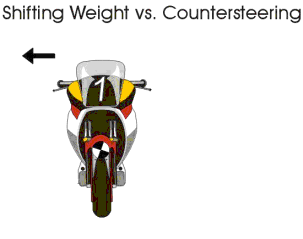|
Countersteering This is one of the most difficult subjects to explain, yet we all use this while riding, mostly by learned instinct. Countersteering is used every time you start to make a turn above the speed of 10 to 12 miles per hour. The inability to use countersteering correctly is what causes children to fall when learning how to ride a bicycle. Some children intuitively pick up on this maneuver quicker then others allowing them to get on a bike and ride in one day. Others have to fall a few times... Countersteering can be practiced by setting up cones and maneuvering through them above the minimum effective speed. At higher speeds, countersteering is used to quickly swerve around road obstacles. This maneuver forces your bike to become off balance on purpose. Off balance means that your bike is no longer vertical, but now leaning to one side. This purposely makes the bike lean and allows you to make a turn. EXAMPLE: To make a right turn - "push" your right handlebar - this causes the bike to be thrown off balance making it lean to the right - now you can complete the right hand turn by continuing the lean, turning the handlebars into the turn (right) and completing the turn.
At higher speeds, countersteering causes the "tires" to move out from underneath the rider. This allows riders to make that quick maneuver around a road obstacle by doing a double countersteer - push quick one direction, which movers the tires to one side, then countersteer the opposite direction to regain the vertical position. At higher speeds - above 30 miles per hour especially - motorcycles do not want to turn. This is mostly due to the gyroscopic effects of the tires spinning. Therefore, countersteering must be used in order to control a motorcycle through curves and turns in the highway. Here are some links to others that have explained this maneuver |
